Pogona
Pogona is a genus of reptiles containing eight lizard species (though some sources say nine or ten) which are often known by the common name bearded dragons. The name "bearded dragon" refers to the "beard" of the dragon, the underside of the throat, which can turn black and puff out for a number of reasons, most often as a result of stress, or if they feel threatened. [2] They are a semi-arboreal species, spending significant amounts of time on branches, in bushes, and near human habitation.[3] Pogona species bask on rocks and exposed branches in the mornings and afternoons. They are found throughout much of Australia in a wide range of habitats such as deserts, shrublands and Eucalyptus woodlands.[4]
| Pogona | |
|---|---|
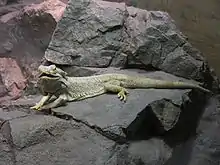 | |
| Pogona vitticeps | |
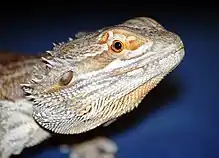 | |
| P. vitticeps – detail of head | |
| Scientific classification | |
| Kingdom: | Animalia |
| Phylum: | Chordata |
| Class: | Reptilia |
| Order: | Squamata |
| Suborder: | Iguania |
| Family: | Agamidae |
| Subfamily: | Amphibolurinae |
| Genus: | Pogona Storr, 1982[1] |
| Species | |
|
Eight species, see text. | |
Several species of this genus, especially the central bearded dragon, are often kept as pets. They can also be exhibited in zoos due to their hardy nature and easy care in comparison to other exotic reptiles.
Description
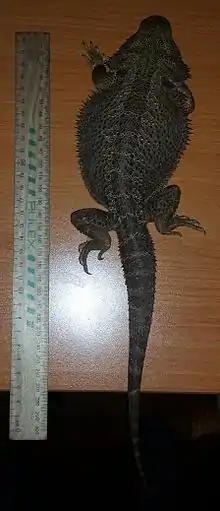


The genus Pogona is in the subfamily Amphibolurinae of the lizard family Agamidae. Characteristics include broad, triangular heads and flattened bodies with spiny scales arranged in rows and clusters. These are found on the throat, which can be expanded when threatened, and at the back of the head. These scales are used to scare off predators, yet they are not very sharp. Bearded dragons display a hand-waving gesture to show submission (most often when acknowledging another bearded dragon's territory), and a head-bobbing display to show dominance between dragons. Some have the ability to slightly change colour during rivalry challenges between males, in response to ambient temperature changes such as turning black to absorb heat, and other stimuli. Males grow up to 60 cm (24 in) long, and females up to 51 cm (20 in). Bearded dragons also produce a mild venom originating from primitive venom glands. Although generally harmless towards humans, it is effective towards smaller-sized animals.[5][6][4]
Habitat
Bearded dragons originate from deserts in Australia, with the various species occupying slightly overlapping areas of the landmass. They live in the arid and subtropical woodlands, scrublands, savannas, shore areas, and into the great interior deserts.[7] Their range extends throughout the interior of the eastern states to the eastern half of South Australia and southeastern Northern Territory.[8] They are considered to be semi-arboreal and will quite readily climb and bask at height. This is also linked to dominance behavior and competition for territory/basking areas. They can be found on fallen/broken trees, rocky outcrops and bushes when basking.[9]
Bearded dragons go through a type of hibernation called brumation. Brumation is like hibernation where reptiles go months without eating but they sporadically drink water. Reptiles go dormant in the hottest temperatures, but it differs from brumation during cooler temperatures. When temperatures are extreme, there is a very small range between temperatures that the reptile's bodies can stay active and where their body cannot tolerate the extreme heat and they die.[10] Bearded dragons go through brumation when the temperature goes below 60–70 °F during the night and 75–80 °F during the day for eight to ten hours.[11] When the climate is too hot they will often burrow underground.[12] They will also form more permanent burrows or covered hiding places to use as protection from the climate changes at night and predation.
Behavior
Adult bearded dragons are very territorial. As they grow, they establish social hierarchies in which displays of aggression and appeasement form a normal part of their social interactions. A dominant male will adopt a dominant stance and sometimes ready himself for a fight to attack a male aggressor to defend territory, food sources, or in competition for a female. Any male approaching without displaying submissive behavior will be seen as a challenge for the territory. Aggressive males have even been known to attack females who do not display submissive gestures in return.
Correspondingly, adult male bearded dragons can bite more forcefully than adult females and this difference is associated with greater head dimensions. [13]
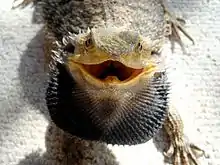
The bearded dragon comes in many different colors. The beard itself is used for both mating and aggression displays and forms part of a range of gestures and signals through which the dragons have basic levels of communication. Both sexes have a beard, but males display more frequently, especially in courtship rituals. Females also display their beard as a sign of aggression. The beard darkens, sometimes turning jet black, and inflates during the display. The bearded dragon may also open its mouth and gape in addition to inflating its beard to appear more intimidating. Extreme behavior such as hissing can be observed when threatened with a predator, inflating the body and tilting towards the threat in defense. Bearded dragons have relatively strong jaws but will often only attack as a last resort when threatened outside of competition with their own species.
Head bobbing is another behavior seen in both females and males; they quickly move their head up and down, often darkening and flaring their beard. Changes in the pace of head bobbing are thought to be a form of communication. Males head bob to impress females, and a male will often have to demonstrate his dominance when attempting to mate before the female will concede. Smaller males will often respond to larger males head bobbing by arm-waving, which is a submissive sign. Females will also arm wave to avoid aggression, often in response to a male's head bobbing.[14] Female bearded dragons have been seen lowering themselves towards the ground and intermittently arm-waving whilst moving away from a dominant male in an attempt to either appease or escape.
The bearded dragon has also been shown to perceive illusion, specifically the Delboeuf illusion. In an experiment at the University of Padova, bearded dragons were presented with two different sized plates with the same amount of food.[15] The bearded dragons chose the smaller plate more often than they chose the larger one, showing that they were able to perceive the illusion and interpret that a larger plate does not always mean more food. This is the first evidence of this behavior being shown in a reptile species.
Reproduction
When brumation comes to an end the male bearded dragon goes out to find a mate. A courtship ritual occurs where the male starts bobbing his head, waving his arms, and stomping his feet in front of the female. The male chases the female and will bite the back of her neck and hold on while he gets in position to copulate.[16]
During the breeding period, female bearded dragons can store sperm in the oviductal crypts.[17] This allows the female bearded dragon to lay a clutch of 11–30 eggs twice from one mating.[18]
When breeding bearded dragons, the incubation temperature can change the sex of the baby within the egg regardless of its sex chromosomes. If the eggs are incubated at a higher temperature (34 °C/93.2 °F and higher), the hatchlings will be female and when the eggs are incubated at a lower temperature (30 °C/86.0 °F and lower) they will be male.[19]
Congenital defects
During the development of an embryo, abnormalities may result in birth defects. These abnormalities might be caused by chromosomal disorders, chemicals, or other genetic or environmental factors.
- Bicephalism
- Bicephalism is when a bearded dragon is born with two heads and one body.[20]
- Anasarcia
- Anasarcia is when a bearded dragon is swollen within the egg. Observing eggs in the incubator, an anasarca egg will appear to be sweating. The cause of this is not known.[20]
- Shistosomus reflexa
- Shistosomus reflexa is when the organs of a bearded dragon develop outside of the body.[20]
- Spinal and limb defects
- Spinal and limb defects are abnormalities in the spine, tail, limbs, or toes. This occurs when there are nutritional deficiencies, trauma, or temperature issue during the development of the affected area.[20]
- Micropthalmia/Anopthalmia
- Micropthalmia / Anopthalmia is when a bearded dragon is born with small eye(s) or no eye(s) The cause of these defects is a traumatic event or an environmental event that occurred during the development of the eyes.[20]
- Hermaphroditism
- Hermaphroditism is when the reproductive organs of both male and female are present. When a bearded dragon is born with both reproductive organs, infertility is the result.[20]
Species
The following eight species are recognised as being valid.[21]
- Pogona barbata (Cuvier, 1829) – Eastern bearded dragon
- Pogona henrylawsoni (Wells & Wellington, 1985) – Rankin's dragon, Lawson's dragon, Black-soil bearded dragon, Dumpy dragon, Dwarf bearded dragon
- Pogona microlepidota (Glauert, 1952) – Kimberley bearded dragon, Drysdale river bearded dragon
- Pogona minima (Loveridge, 1933) – Western bearded dragon
- Pogona minor (Sternfeld, 1919) – Western bearded dragon, Dwarf bearded dragon
- Pogona mitchelli (Badham, 1976) – North-west bearded dragon, Mitchell's bearded dragon
- Pogona nullarbor (Badham, 1976) – Nullarbor bearded dragon
- Pogona vitticeps (Ahl, 1926) – Central bearded dragon or inland bearded dragon
Nota bene: A binomial authority in parentheses indicates that the species was originally described under a different binomial.
In captivity
Bearded dragons are kept as pets. The central bearded dragon is the most common species in captivity, with some smaller species such as Pogona henrylawsoni being used as substitutes where there is less housing space available.
Introduced into the U.S. as pets during the 1990s, bearded dragons are a species that have gained much popularity as an exotic pet. This popularity has been sustained, even after Australia banned the sale of its wildlife as pets in the 1960s.[22] Generally speaking, the bearded dragon is a solitary animal. Male bearded dragons are usually housed alone, as they will fight with other males and breed with females. Captive adults reach about 40 to 61 cm (16 to 24 in) from head to tail, weigh 350 to 600 g (10 to 20 oz)[23] and live for about 10 to 12 years with good care.[4] They have been known to live up to about 14 years in captivity, and the current world record is 18 years.[24]
Through selective breeding, there are many different versions of the Central Inland Bearded Dragon; these are referred to as “Morphs”. There are a few main genetic traits, Hypomelanism and Translucents, which refer to traits physically displayed by the dragon. Hypomelanism (or Hypos) tend to have more vibrant coloration and lighter colors, as well as very light brown/, see-through claws. Translucents (or Trans) have a slightly opaque quality to their skin, making their colors seem stronger, and also have black eyes. There are also “Leatherbacks” (reduced scale texture to give a smoother skin), “Silkbacks” (Highly reduced scale texture and very soft outer skin) and “German Giants” (noticeably larger than your average bearded dragon) Silkbacks in particular require special care as they have far more delicate skin and as such require different UV and humidity requirements. They also tend to live shorter lifespans.
Added to this there are various patterns, such as “Tiger”, and color types, such as “Citrus” (yellows and greens), “Oranges” and “Reds”; there are also more extreme morphs that have been bred such as “Witblits” (Light Grey/Smokey), “Paradox" (the coloration has patches where grey/purple patches appear instead of its normal skin color) and “Zeros” (Smokey Grey with purple tints and almost see-through skin).
Over the years, many different breeders have selectively bred certain lines to emphasis these traits and will often name their own such as "Dunner", “Rainbow Tigers”, “Sandfire” or “Fire & Ice”, all with either their own coloration, patterns or physical traits.
Captive diet
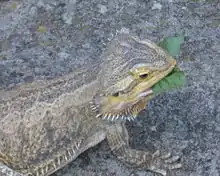
Juvenile and baby bearded dragon diets consist mainly of insects, and they require substantial amounts of protein. A juvenile bearded dragon eats insects three times a day on average. After a few feedings, the dragon's usual appetite can be determined.[25] Crickets and dubia roaches are the most popular insects fed to bearded dragons, but they can also be fed other insects such as black soldier fly larvae, spiders, locusts, superworms, silkworms, butterworms, fruit flies, grasshoppers, mealworms and hornworms. Bearded dragons also eat increasing amounts of plant-based food as they grow; adults should have a diet consisting primarily of plant matter, the most important of which are leafy greens.[26] Spring greens, endive, kale, rocket, Chinese leaf, and watercress are all suitable vegetables, as are butternut squash, pea shoots, bell peppers, and many other plants. It is important to check before feeding something new to a bearded dragon, as some things can be toxic to them or will act to bind calcium in their diet, preventing them from being able to absorb calcium. This diet is also seasonal, meaning that it changes with the availability of live prey in the wild. Studies of wild Pogona vitticeps have shown that termites compose over 60% of the stomach contents of those studied. Bearded dragons, like many reptiles, are opportunistic and will binge feed on live food sources where available, preferring live prey over plant matter. Bearded dragons also require supplements to stay healthy, including calcium, vitamin D, and a multivitamin. These supplements are typically powdered and are administered by dusting their food with them. [27]
Common health issues
Although bearded dragons are fairly resilient to illness, improper care can potentially fatally hurt a bearded dragon. Some health issues that bearded dragons may have include: metabolic bone disease, adenovirus, impaction, polarisation, and parasites. The majority of health issues bearded dragons face in captivity are due to poor diet and inadequate heat and lighting.
Metabolic bone disease
Metabolic bone disease (MBD) is a collective term for several common diseases/illnesses that can be fatal for bearded dragons. A main attribute of MBD is the weakening of the skeletal structure and possible deformation. It occurs in bearded dragons due to malnutrition or the use of improper lighting, meaning they are unable to properly assimilate calcium from their diet or there isn't enough in their diet. Most bearded dragons in captivity will be fed supplementation and all will need a UVB light to enable them to properly use calcium in their diet. Typical foods that bearded dragons eat, including kale, mustard greens, and collard greens, are high in calcium and should be eaten daily along with other leafy greens and vegetables to have a well-balanced diet[28] Bearded dragons require UVB lights to process calcium in their diet. Without processing this calcium, their bodies will use calcium from their bones, therefore weakening them. Symptoms seen in bearded dragons with MBD include bumps in the legs, twitches or tremors, bumps along the spine or tail, a swollen bottom jaw, and jerky movements.
Hypocalcemia
Hypocalcemia occurs when there are low levels of calcium in the bearded dragon's blood. Hypocalcemia is most often tied to metabolic bone disease. Low levels of calcium can result in twitching muscles, or seizures. Hypocalcemia is most often seen in young bearded dragons, as they are slightly more fragile than adults. Maintaining a diet that consists of enough calcium is crucial to avoiding hypocalcemia as well as metabolic bone disease.[29]
Impaction
Impaction occurs often in bearded dragons when they are fed food that is too big for them. Bearded dragons will try to eat worms or crickets that are too big for them, but this can be extremely harmful. Food should not be bigger than the space between their eyes for a young dragon. Older dragons can generally cope with larger insects but not oversized prey. If a dragon eats food that is too big for it, pressure will be put on its spinal cord during digestion. This pressure can lead to Impaction which can lead to death.
Atadenovirus
Atadenovirus (ADV), also referred to as adenovirus, is a viral disease that can be deadly. ADV can be spread between reptiles through contact alone. Most juvenile ADV-positive bearded dragons don't live past 90 days. While ADV-positive adults will live longer, they eventually contract liver diseases.[30] Common symptoms of ADV-positive bearded dragons include stunted growth and slow weight gain. Because of their compromised immune systems, ADV-positive bearded dragons may be infected with intestinal parasites.[31]
Lighting
Bearded dragons require UVB to enable Vitamin D3 synthesis and to prevent illnesses like metabolic bone disease. Vitamin D3 is essential to calcium absorption, with calcium playing a major role in various critical biological functions. Bearded dragons also require UVA; this wavelength stimulates feeding, breeding, basking and overall health. They also require a basking heat source, most commonly a light-emitting source, to provide a basking area. Heat and UV are both vital to the bearded dragons' biological function.
Lifespan
In the wild, while the average lifespan tends to be much shorter, with adequate conditions, exceptional bearded dragons may live up to 20 years when not eaten as prey.[32]
See also
References
- Wells, Richard W.; Wellington, C. Ross. 1985. "A Classification of the Reptilia and Amphibia of Australia". Australian J. Herp. Suppl. Ser. (1): 1–61. (Genus Pogona, p. 19).
- "8 Reasons For Your Bearded Dragonś Black Beard". beardeddragontank.com.
- "Housing". Care of Bearded Dragons (Pogona vitticeps). Retrieved 19 December 2019.
- Browne-Cooper, Robert; Brian Bush; Brad Maryan; David Robinson (2007). Reptiles and Frogs in the Bush: Southwestern Australia. University of Western Australia Press. p. 160. ISBN 978-1-920694-74-6.
Pogona minor minor, Abrolhos Bearded Dragon
- Fry, Bryan G.; Vidal, Nicolas; Norman, Janette A.; Vonk, Freek J.; Scheib, Holger; Ramjan, S. F. Ryan; Kuruppu, Sanjaya; Fung, Kim; Blair Hedges, S.; Richardson, Michael K.; Hodgson, Wayne. C.; Ignjatovic, Vera; Summerhayes, Robyn; Kochva, Elazar (2005). "Early evolution of the venom system in lizards and snakes". Nature. 439 (7076): 584–588. doi:10.1038/nature04328. ISSN 0028-0836. PMID 16292255. S2CID 4386245.
- Fry, Bryan G.; Roelants, Kim; Champagne, Donald E.; Scheib, Holger; Tyndall, Joel D.A.; King, Glenn F.; Nevalainen, Timo J.; Norman, Janette A.; Lewis, Richard J.; Norton, Raymond S.; Renjifo, Camila; de la Vega, Ricardo C. Rodríguez (2009). "The Toxicogenomic Multiverse: Convergent Recruitment of Proteins Into Animal Venoms". Annual Review of Genomics and Human Genetics. 10 (1): 483–511. doi:10.1146/annurev.genom.9.081307.164356. ISSN 1527-8204. PMID 19640225.
- Bearded dragon natural habitat. https://thepetenthusiast.com/bearded-dragon-care/#Natural-Habitat
- "Central Bearded Dragon - Pogona vitticeps - Australian Museum". australianmuseum.net.au. Retrieved 19 April 2018.
- "Bearded Dragon (Pogona) Species Profile: Habitat, Diet, and Care". www.peteducation.com. Archived from the original on 29 May 2015. Retrieved 23 September 2015.
- Mayer, William Vernon. “Dormancy.” Encyclopædia Britannica, Encyclopædia Britannica, Inc., 17 May 2016, www.britannica.com/science/dormancy#ref1121981.
- Vosjoli, Philippe De. The Bearded Dragon Manual: Expert Advice for Keeping and Caring for a Healthy Bearded Dragon. 2nd ed., Lumina Media, 2016.
- "Why Do Bearded Dragons Burrow? - Online Bearded Dragon Care". Retrieved 23 September 2015.
- Jones MEH, Pistevos JC, Cooper N, Lappin, AK, Georges A Hutchinson MN, Holleley CE. (2020). "Reproductive phenotype predicts adult bite-force performance in sex reversed dragons (Pogona vitticeps)". Journal of Experimental Zoology, Part A. 333 (4): 252‒263. doi:10.1002/jez.2353. hdl:10141/622643. PMID 32061035.CS1 maint: multiple names: authors list (link)
- Periat, Jennifer (Pat. J.) (17 February 2000). Harding, James (ed.). "Pogona vitticeps central bearded dragon". Animal Diversity Web. Retrieved 27 June 2020.
- Santacà, M.; Miletto Petrazzini, M. E.; Agrillo, C.; Wilkinson, A. (2019). "Can reptiles perceive visual illusions? Delboeuf illusion in red-footed tortoise (Chelonoidis carbonaria) and bearded dragon (Pogona vitticeps)". Journal of Comparative Psychology. 133 (4): 419–427. doi:10.1037/com0000176. PMID 30896231.
- Green, Darren. Keeping Bearded Dragons Pogona Species. Australian Reptile Keeper, 2009.
- Amey Andrew P. Whittier Joan M. (2000) The annual reproductive cycle and sperm storage in the bearded dragon, Pogona barbata. Australian Journal of Zoology 48, 411–419.
- Hosking, Chris. “Australian Museum.” Central Bearded Dragon - Pogona Vitticeps, 2 May 2017, australianmuseum.net.au/central-bearded-dragon.
- Yong, Ed. “Hot Wild Dragons Set Sex Through Temperature Not Genes.” Phenomena, National Geographic | Phenomena, 1 July 2015, phenomena.nationalgeographic.com/2015/07/01/hot-wild-dragons-set-sex-through-temperature-not-genes/.
- Brown, Danny. A Guide to Australian Dragons in Captivity. ABK Publications, 2012
- "Pogona ". The Reptile Database. www.reptile-database.org.
- "Exports of Australian native plants and animals". environment.gov.au. Retrieved 19 March 2018.
- "Hades Dragons". hadesdragons.co.uk. 2010. Archived from the original on 5 November 2013. Retrieved 13 August 2013.
- "Oldest bearded dragon ever". Guinness World Records. Retrieved 12 August 2018.
- "Bearded Dragon Care". Big Al's Pets. December 2014. Archived from the original on 28 January 2015. Retrieved 14 January 2015.
- Bearded Dragon Food Pyramid 15 April 2016. Complete Critter. http://www.completecritter.com/bearded-dragon.html
- https://beardiebungalow.com/bearded-dragon-supplements/
- "MBD". www.beautifuldragons.com. Retrieved 4 May 2017.
- Tricia Power (1995–2012). "Calcium Deficiency". Tricia's Chinese Water Dragon, Reptile and Amphibian Care Page. Retrieved 5 May 2017.
- "Atadenovirus – This Disease Can Be Deadly To Your Bearded Dragon". www.reptilesmagazine.com. Archived from the original on 22 May 2017. Retrieved 5 May 2017.
- Bjornebo, Heather (11 August 2016). "Atadenovirus in Bearded Dragons". azeah.com. Retrieved 5 May 2017.
- "Pogona vitticeps". AnAge entry. Retrieved 14 April 2018.
Further reading
- Storr GM. 1982. "Revision of the Bearded Dragons (Lacertilia: Agamidae) of Western Australia with Notes on the Dismemberment of the Genus Amphibolurus ". Rec. Western Australia Mus. 10 (2): 199–214. (Pogona, new genus, p. 201).
External links
| Wikispecies has information related to Pogona. |
| Wikimedia Commons has media related to Pogona. |
- "Bearded Dragon Care Sheet". Reptile Range. Retrieved 28 January 2021.